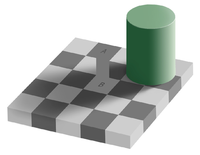User:KYPark
Jump to navigation
Jump to search
Cognitive biases in context[edit]
- Hard evidences
- For causalism, contextualism, connectionism, behaviorism, etc.
- Against universalism, nativism, innatism, cognitivism, etc.

|
| Illusion everywhere! The background is a colour gradient and progresses from dark grey to light grey. The horizontal bar appears to progress from light grey to dark grey, but is in fact just one colour! |

|

|
Symbolic biases[edit]
- Antinomy or self-contradiction
A equals to B. A varies from B. |
Man is an animal. Man is no animal. |
Triangle of reference (1923)[edit]
| THOUGHT OR REFERENCE | ||
|---|---|---|
| CORRECT* Symbolises (a causal relation) |

|
ADEQUATE* Refers to (other causal relations) |
| SYMBOL | Stands for (an imputed relation) TRUE* |
REFERENT |
The Treachery of Images (1929)[edit]
| ||
| Ceci n'est pas une pipe. |
Walker Percy (1975)[edit]
Simon Blackburn (1984)[edit]
| speakers (psychology) | ||||
|---|---|---|---|---|
| theory of meaning |  
|
theory of knowledge | ||
| language (meaning) |
world (metaphysics) | |||
David Chandler (1994)[edit]
- Daniel Chandler (1994). Semiotics for Beginners (WWW document).
- A parody of #The Treachery of Images (1929) [1]
- The following parody of #Triangle of reference (1923) [2]
| sense SIGN |
|---|

|
| sign vehicleABC referent |
Triangle of reference extended[edit]
| encoder | ||
|---|---|---|
| encoding decoded |

|
encoded decoding |
| decoder | ||
Comments[edit]
- ↑ The cognitive bias or partiality may be inborn as well as rationality.
- ↑ "This is not a pipe," precisely, as the image is not the real-life or what is imaged, or as "the map is not the territory" as Alfred Korzybski's dictum (1933) reads. Nevertheless, to say "This is a pipe" may mean to say concisely "This is an image of a pipe."
- In ... "Ceci n'est pas" works, Magritte points out that no matter how closely, through realism-art, we come to depicting an item accurately, we never do catch the item itself. -- An excerpt from René Magritte.
Notes[edit]
- ↑ In this illusion, the coloured regions appear rather different, roughly orange and brown. In fact they are the same colour, and in identical immediate surrounds, but the brain changes its assumption about colour due to the global interpretation of the surrounding image. Also, the white tiles that are shadowed are the same colour as the grey tiles outside the shadow.
- ↑ This is known as the checker shadow illusion, aka, same color illusion.
- ↑ This antinomy occurs when the relationship of A and B of the above checker shadow illusion, that is, a cognitive bias is narrated or symbolised. It may be too hard for symbolism to overcome the bias or partiality of idealism.
